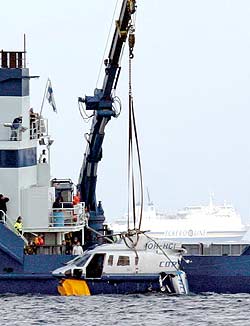Sikorsky rejects verdict of main rotor servo failure in Copterline accident as NTSB recommendations are ignored
Controversy over the cause of the fatal accident involving a Copterline Sikorsky S-76C+ helicopter in August 2005 has deepened following Estonian accident investigators' confirmation of US National Transportation Safety Board (NTSB) findings that the probable cause was failure of a main rotor servo.
But NTSB recommendations described in November as "urgent" have still not been impemented in around 600 affected S-76s.
 Tõnu Ader, deputy head of the Estonian accident investigation commission, says "thorough investigation into the crash leaves no room for doubt as to the cause". He confirms that one of the main rotor servos was rendered useless by flakes of copper-aluminium plasma coating blocking the hydraulic ports, leading to catastrophic failure of the servo and loss of the helicopter's controllability. "Servo malfunction and plasma flaking is not disputable any more," he says. The accident, on a scheduled flight between Tallinn and Helsinki, Finland, killed 12 passengers and two crew.
Tõnu Ader, deputy head of the Estonian accident investigation commission, says "thorough investigation into the crash leaves no room for doubt as to the cause". He confirms that one of the main rotor servos was rendered useless by flakes of copper-aluminium plasma coating blocking the hydraulic ports, leading to catastrophic failure of the servo and loss of the helicopter's controllability. "Servo malfunction and plasma flaking is not disputable any more," he says. The accident, on a scheduled flight between Tallinn and Helsinki, Finland, killed 12 passengers and two crew.
Sikorsky rejects the findings, saying it and servo manufacturer HR Textron "do not agree that the servo caused the mishap". In December the company issued an all-operators letter recommending that operators carry out internal leakage tests of all S-76 main rotor servos. The manufacturer insisted, however, that testing to date with an intentionally degraded servo "has not identified any safety of flight issues" and pointed out that the Federal Aviation Administration "has not issued an airworthiness directive requiring fleet action".
NTSB seeks answers |
|---|
| In ground tests and aerodynamic simulations, the NTSB proved that an uncommanded extension of the forward actuator resulted in exactly the same violent out-of-control helicopter behaviour as had been revealed by the flight data recorder (FDR). The Copterline S-76C was the first helicopter with an FDR to be investigated by the NTSB. The NTSB also demonstrated that the forward actuator recovered from the accident aircraft failed a manufacturer's acceptance test. While this did not in itself mean the actuator was unsafe, it says "the degree and manner in which this actuator failed portions of the test demonstrates that control of the actuator was lost and that an unsafe condition existed in it". Subsequent disassembly of the actuator revealed large pieces of plasma coating had flaked off the servo piston, there was excessive wear on the piston, pieces of the plasma had blocked one of the two return ports in the servo control valve, and numerous pieces of plasma coating were found throughout the actuator. |
The FAA issued a notice of proposed rulemaking in May proposing an airworthiness directive (AD) that would require inspection of all S-76 actuators for contamination and leakage and dictating reduced overhaul intervals. "The issue is very complex and we need to ascertain, with sufficient certainty, that a potential safety issue exists before we impose action via an AD," says the FAA.
Source: Flight International























